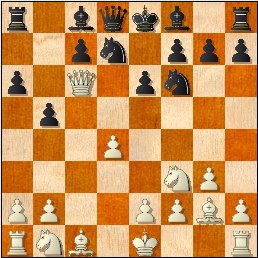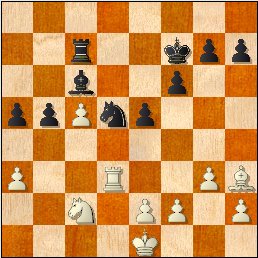[Annotator: Bronstein, David]
A weakness of the dark squares is also a weakness of the pieces and pawns on the light squares. Light-square weaknesses are also possible, resulting in a weakening of the enemy pieces on the dark squares. The point of an attack on the dark squares is that by placing my pawns and pieces on the dark, I attack my opponent’s pieces and pawns on the light. This game provides a clear example of the method of exploiting dark square weakness; and the combination which was possible after Black’s 24th move begs to be included in a textbook, taking place as it does entirely on light squares.
1.c4 Nf6 2.g3 e6 3.Bg2 d5 4.d4 dxc4 5.Qa4+ Nbd7 6.Nf3 a6 7.Qxc4 b5 8.Qc6 Diagram

Having hatched a plan to weaken the enemy dark squares, Szabo undertakes a delicate maneuver aimed at bringing about the exchange of the dark square bishops, which will further strengthen his grip on the dark squares.
8…Rb8 9.Bf4 Nd5 10.Bg5 Be7 11.Bxe7 Qxe7 12.0-0 Bb7 13.Qc2 c5 14.dxc5 Nxc5 15.Rc1 Rc8 16.Nc3 Nf6 Diagram

A small but serious inaccuracy; Black removes this piece from the main theater of operations.[16…Nb6 much better for Black. Increases control of c4 and makes it more difficult for White to play b4.]
17.b4 Na4 18.Qb3 Nxc3 19.Rxc3 Rxc3 20.Qxc3 0-0 21.Rc1 Rd8 Geller cannot take the c-file away from his opponent, for if 21…Rc8 White would take the rook 22.Qxc8+ Bxc8 23.Rxc8 Ne8 24.Ne5! and there is no stopping 26.Bc6 [21…Rc8 22.Qxc8+ Bxc8 23.Rxc8+ Ne8 24.Ne5 ]
22.a3 Diagram

22…Nd5 Seeing the White’s positional squeeze could become very dangerous, should he succeed in occupying the seventh rank or in establishing his knight on c5, Geller decides to complicate (his move also stops both threats).
23.Qd4 f6 24.Ne1 e5 25.Qc5 A consistent but rather uninspired continuation. [25.Qa7 Retaining his hold of the dark squares while attacking the pieces on the light squares.]
25…Qxc5 26.bxc5 White would have maintained a clear advantage with 26.Rxc5, but Szabo probably thought that his pin on the knight, combined with his threat to advance the c-pawn would assure him victory. However, Black finds the defensive maneuver …Rd8-d7-e7.
26…Bc6 27.Rd1 Rd7 28.Bh3 Re7 29.Nc2 a5 30.Bg2 Rd7 31.Bh3 Re7 32.Kf1 Szabo declines the repetition, although he no longer has the better position. This is a psychological error common to chess players of all ranks.
32…Kf7 33.Ke1 This was White’s last chance to force the draw with Bh3-g2-h3.
33…Rc7 34.Rd3 Diagram

34…Bb7 And now White will lose his c-pawn.
35.Ne3 Rxc5 36.Nf5 Bc6 37.Nd6+ Kf8 38.Bg2 g6 39.Kd2 Ke7 40.Ne4 Rc4 41.f3 f5 42.Nf2 Ra4 43.Nd1 e4 44.fxe4 fxe4 45.Rb3 Rd4+ 46.Kc1 Diagram

46…b4 Black’s plan is simple: to create a passed pawn and Queen it. White can offer no real resistance to this.
47.Ne3 Nc3 48.axb4 Nxe2+ 49.Kb1 Ba4 50.Rb2 Nc3+ 51.Kc1 axb4 52.Rd2 Rxd2 53.Kxd2 Kd6 54.Ng4 Kc5 55.h4 Kd4 56.h5 gxh5 57.Ne3 Nb1+58.Ke2 Bb5+ 59.Kf2b3 0-1 Diagram

Nice work, but would be much easier to follow – especially for beginners – if one could follow along on a (flash or similar) board in which the sides could be switched.